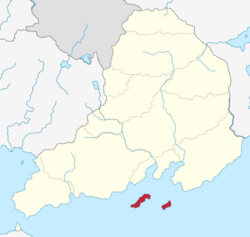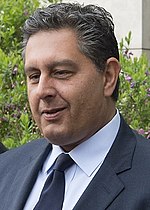Valdinas Islands
This article is incomplete because it is pending further input from participants, or it is a work-in-progress by one author. Please comment on this article's talk page to share your input, comments and questions. Note: To contribute to this article, you may need to seek help from the author(s) of this page. |
Autonomous Region of the Valdinas | |
|---|---|
 The Valdinas within Atresca | |
| Country | Atresca |
| Status | Autonomous region |
| Statute of Autonomy | 1996 |
| Capital | Librizzi |
| Government | |
| • Governor | Andrea Finocchiaro |
| • Legislature | Senate |
| Population (2016) | |
| • Total | 1,575,902 |
| Demonym | Valdinian |
| GDP (PPP) | |
| • Total | $36.4 billion |
| • Per capita | $23,100 |
| GDP (nominal) | |
| • Total | $30.7 billion |
| • Per capita | $19,500 |
| Time zone | UTC+1 (Western Asura Standard Time) |
| Official languages | Valdinian Atrescan |
The Valdinian Islands (Valdinian: Ìsuli Vaddinas), also known as the Valdinas (Valdinian: Las Vaddinas), is an autonomous region off the southern coast of Atresca. In 2016, the region had a population of 1,575,902. The regional capital is Librizzi, the largest city. It is divided into two provinces: Valdina and Furnari.
The Valdinas are located in the eastern Asur Sea and are separated from the Atrescan mainland by the Strait of Albasani. Together, the islands form a small archipelago. The eastern island of Valdina is defined by by hills and plains. Furnari, located in the west, has a rocky and jagged coastline and a mountainous interior. Mont Avic, an active volcano located on Furnari, is one of the Valdina's most famous landmarks. The islands have an Asur climate.
Humans have lived on the islands since 12,000 BCE. Colonies were established by the Myrians starting in 650 BCE. The islands were conquered by the Fiorentine Empire and gradually the dominance of Myrian declined. After the fall of the Fiorentines in 492 CE, the Valdinas were ruled independently. They sided against the Atrescan League in the Pontifical War and subsequently lost their independence. The islands became part of the Kingdom of Atresca following unification in 1858. Following a political instability, economic downturn, and a low-level insurgency the Valdinas were granted special status as an autonomous region in 1996.
The Valdinas have their own devolved government. The Regional-Governor leads the Valdinian government and has executive powers. The Valdinian Senate servers as the regional legislature. Most political parties active in the Valdinas are regionally focused. Several support independence while others back further devolution or want to maintain the status quo. The current Regional-Governor is Andrea Finocchiaro, who was elected in 2015.
Despite having been part of varying Atrescan states for over 400 years, the Valdinas have retained a strong cultural identity. The Valdinas have a unique and rich culture with significant achievements in the arts, literature, music, and cuisine. The islands have many important archaeological sites and are visited by thousands of tourists annually. Librizzi International Airport serves international travelers.
History
Physical geography
Flora and fauna
Politics
The 1996 Statue of Autonomy implemented a framework of a presidential representative democracy. The Regional-Governor is the head of government and leads the Regional Government, which exercises executive power. The Regional-Governor appoints members of the Executive Council which overseas regional governmental departments. As an autonomous region of Atresca, Eleonora in her capacity as Queen of Atresca also serves as the monarch of the Valdinas. She has few reserved powers, all of which are ceremonial. The most significant is the ceremonial right to officially appoint the Regional-Governor. The Regional-Governor is directly elected every four years. Andrea Finocchiaro has held the post since 2016 and was re-elected in January 2020.
Legislative power is delegated to the Valdinian Senate. The Valdinas has a multi-party system. Over a dozen regionally-focused parties hold official at a regional and local level. The Senate has 100 members who are elected alongside the Regional-Governor every four years. The last election was held in January 2020 and a legislative majority in support for Fionocchiaro's presidency has not yet formed.
Traditionally, the Valdinas supports centre-right parties and politicians. The two largest parties in the regions are the liberal Democratic Party of the Valdinas (PDdV) and the Alydian democrat Valdinian Peoples' Party (PdPV). There are a number of parties that support increased devolution and some that are separatist. The centre-left Party for Our Republic is the main separatist party in the Valdinas. It won the most seats in the 2020 election. Other separatist political parties include the right-wing Rally for the Valdinas! and the centrist Valdinian Nation. Regional-Governors are typically supported by electoral alliances that form around specific candidates. Finocchiaro leads the centre-right Finocchiaro List, an alliance the PDdV, the PdPV, and several local parties.
Administrative divisions
Demographics
Largest cities
The following table shows the ten largest cities of the Valdinas.
| Pos. | Name | Pop. 2016 |
Prov. |
|---|---|---|---|
| 1 | Librizzi | 168,460 | Valdina |
| 2 | Reitano | 117,125 | Valdina |
| 3 | Salemi | 73,985 | Valdina |
| 4 | Vita | 57,900 | Valdina |
| 5 | Caronia | 44,189 | Valdina |
| 6 | Marsala | 36,540 | Furnari |
| 7 | Balestrate | 33,861 | Valdina |
| 8 | Enna | 27,923 | Valdina |
| 9 | Modica | 24,212 | Furnari |
| 10 | Tusa | 22,317 | Valdina |
Economy
After years of steady economic growth, the Valdinas are among the largest regional economies of Atresca in terms of total gross domestic product. Economic reforms designed to increase competitiveness in manufacturing and agriculture have contributed significantly to the growth of the regional economy. The service industry has also emerged as an important part of the Valdinian economy. There has also been a modest growth in the financial and telecommunication sectors centered in Libirzzi. Despite recent economic development, the Valdinas continue to have a GDP per capita below the Atrescan average and a higher unemployment average. The difference is in part attributed to corruption, the negative influence of the Mafia, and a emigration.
Agriculture
The fertile soil of the Valdinas has resulted in the prominence of agrarian culture since ancient times. The central plain on the island of Valdina is especially suitable for wheat farming. Other notable agricultural products include cheese, wine, olive oil, and tomato all of which are major agricultural exports. Olives and grapes are planted and harvested in hilly areas. In recent decades, the production of citrus fruits has begun. Oranges have become a popular Valdinian export.
The islands are home to a number of vineyards which are known for their red wines. The best known is the Furnari sweet blend. It is produced from grapes grown and distilled in Furnari. Cork oak grows naturally on the islands and the islands produce a significant amount of Atrsescan cork. The wine industry also plays an important role for tourism to the Valdinas.
Meat and seafood are also major sectors of Valdinian agriculture. There are over a million sheep that live on the islands. For thousands of years, the islands have specialized in sheep breeding. Goats and cattle are also present in the Valdinas, though they tend to be less productive in terms of land use compared to sheep. There are a number of important fisheries in the Valdinas. Sardine, swordfish, and tuna are caught and exported worldwide. Salemi is the main fishing centre in the Valdinas and one of the most important in Atresca.
Industry and manufacturing
The Valdinas have a small but robust heavy industrial sector. The region's industry is dominated by petrochemicals. Chemical industries, oil refineries, and major power stations are significant employers. There are oil and natural gas fields on the southeast coast of Valdina. Furnari has one of the largest deposits of halite and is one of the largest sea salt producers in Asura.
Due to the importance of agriculture, there are also food industries throughout the Valdinas. There is a small electronics industry centered in Reitano. There are some important shipyards in Librizzi.
Finance and service sectors
The region has a modest financial services sector. It is Centred in the regional capital of Libirzzia, where several international companies maintain offices. Information technology is also a growing part of the Valdinian economy. Economic reforms in recent years have been implemented in order to further develop these sectors.
Services are also an expanding industry in the region. Several shopping malls have opened in recent decades. Tourism is a major component of the service sector and a major source of employment for the islands. The islands' dry climate and coastal scenery draw millions of tourists each year. Seaside tourism accounts for the majority of the tourism industry. The history and cuisine of the islands also attract visitors. The region has a number of archaeological and world heritage sites. In 2015, there were over 2,500,000 arrivals and 10,141,217 passengers registered at the airports of the islands.





